After a long week exploring Florence, we have finally arrived to our last day of the course. We have a long day ahead of us with a visit to GKN Driveline Firenze and Principe Corsini Winery Villa Le Corti. We met our favorite guide, Guido, at the Gonzaga in Florence Campus who led us to the bus station a few miles away where we experienced Italian public transportation on our way to GKN in Capalle.
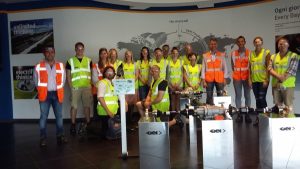
At GKN Reception
When we arrived, we received security badges at reception and observed a little red robot try and mow the lawn at the facility. We made our way to the lobby of GKN and observed a few exhibits about what the company does before being led to a conference room where a few of the managers including Filippo Marinai, Emanuela Bologna, and Jacopo Campolmi gave us a presentation on the overview of GKN Firenze including its management structure, industry segments in which GKN operates, sales, number of employees, products, customers, assets, communication process, and GKN’s integration of industry 4.0.
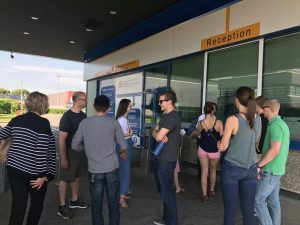
In the GKN Lobby
After the enlightening presentation and a brief safety overview, we were given a few minutes for coffee and pastries. We were introduced to a fancy espresso machine that entertainingly caught our attention. It apparently takes several zags to operate an Italian espresso maker. After a short coffee break, we were escorted to a room with safety equipment to put on before we went on a tour of the factory. We looked pretty good in our neon safety gear.

Zags trying to make espresso

Zags in neon safety gear
Filippo was our guide and explained that GKN make drivelines for many automotive manufacturers including Smart, Fiat, Chrysler, General Motors, Mini, Audi, Land Rover, Jaguar and even high-end vehicles such as Porsche and Ferrari. He led us to a room near the factory entrance with several whiteboards outlining the current operations and goals of the firm. The categories that GKN outlined included Health Safety and Environment, Quality, Supply Chain, Finance, Maintenance, Lean Operations (continuous improvement), and Value Stream Machining. There was also a board with a structured communication process to help increase the efficiency of the firm’s operations.
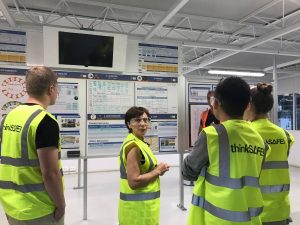
Zags learning about GKN’s operations
GKN Firenze was a clean and organized operation and seemed like a well-oiled machine. Unfortunately, we were not allowed to take photos inside the factory. But it was well laid out and use a lean modular cell design for the different products being produced at any given time. The cell layouts could be rearranged to produce a different product as needed. The technology was state-of-the-art and the use of robots was frequent. GKN Firenze even made use of a top-of-the-line 3D printer to machine prototypes and replacement parts which was another interesting addition to their research and development department is a very large, free-standing 3-D printer. This unit is allowing them to test the production of an aircraft component made with a durable plastic, rather than aluminum, resulting in a much lighter component, which would be of benefit to aircraft manufacturers.
All-in-all, GKN Firenze had a comfortable working atmosphere and is a great place to work. The facility was immaculate and well-lit. The employees seemed comfortable and content. At GKN, several lean-inspired practices caught our eyes (Apart from the little red lawn robot, which we couldn’t stop watching). The company has integrated many bigger-than-life robots into its production lines to perform precise assemblies of various component parts. We were able to see some of the ways that company technicians monitor and repair the robots, when necessary. The robots are obviously one of the ways the company is able to run its factory 24/7, without the need for dozens more employees.
 Zags at a bus stop
Zags at a bus stop
We returned to the safety gear room and quickly removed our gear as to catch our bus back to the city. When we got back to town, we had an hour to get a quick bite before meeting at Santa Maria Novella to catch another bus to the Tuscany countryside. After a 45 minute ride, we arrived at Principe Corsini. Tuscany was exactly like it looks in the photos and movies. When we arrived at Corsini, it was kind of like a dream. There was an outdoor sitting area that was perfect for taking a nap in the afternoon sun with a cold glass of vino bianco, which many of us would do, given the chance.
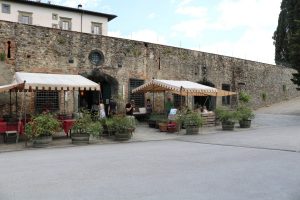
Outside Villa Le Corti | Zags taking naps
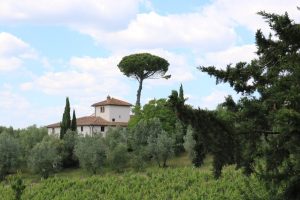
Tuscany, exactly what we expected
Nonetheless, we were led through the winery and our well-educated guide told us all about the history of the winery and the Corsini family as well as the wine making process. We walked through the entire winery which is situated underground, underneath the breathtaking gardens of Villa Le Corti. We walked through rooms with hundreds of barrels for aging the wine as well as more technical areas of the winery with machines for processing the grapes and olives. The Villa is extremely old but well maintained by the family. It had been abandoned for many years before the family returned and turned it into the winery it is today.
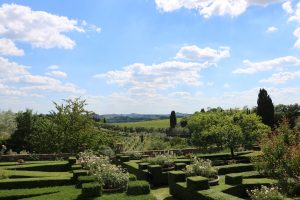 Villa Le Corti Garden
Villa Le Corti Garden
Walking through the facility is like walking through a museum. It is a piece of Italy’s history. The family has kept many of the artifacts that were left there from before including old wine bottles and an entire room filled with hand-made terra cotta barrels that were once used to age wine. We also got the chance to see the facility where olive oil is made. Our guide explained that for their olive oil to receive the highest accreditation, the olives must be processed within six hours of being picked. After six hours, the same olives and process are used to make the olive oil but anything produced after six hours must be bottled and labeled separately.
At Corsini Winery, an interesting footnote is that the estate includes olive trees, which the owners–past and present–use to make olive oil. Wine and olive oil seem like a wonderful combination of Tuscan products, and may give tourists an extra reason to visit the winery! Although not used in this day and age, the very old terra cotta olive oil jugs are kept (see photo) as a testament to the centuries-old practice of turning olives into a culinary staple for kitchens across the world.
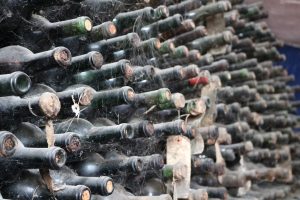
Terra Cotta Barrels /Ancient Wine Bottles
After the tour, we were given the opportunity to meet the manager and learn about the sales and marketing of wine from Principe Corsini. From what we recall, over 40% of their wine is exported to the United States and another 30% is exported to other European countries; France being the largest buyer in Europe. Being such a small producer, it is difficult for the winery to control sales in other countries, especially the United States. Their current strategy is working with a North American buyer that sells to distributors mostly in the North East United States. Corsini hopes to increase their reach in the future but are limited by their current capital.
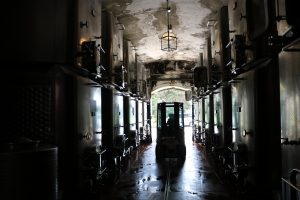
Principe Corsini Winery | Artistic
Following the discussion with the manager, we were seated in a tasting room with a full spread of cheese and meats in front of us as well as selection of three wines and two olive oils for tasting. Needless to say, there was not much left after. With full stomachs and tiredness setting in, we stumbled back to the bus stop and made our way back to Firenze.
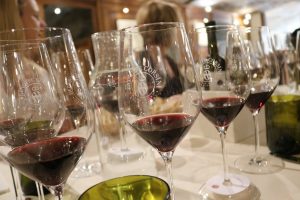
Principe Corsini Wine Tasting
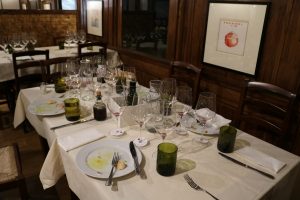
Principe Corsini Wine Tasting | It is all gone
Our last day studying in Florence was a long day packed full of exciting activities. Whether we were observing how a multinational manufacturer uses lean operations or tasting wine fresh out of the barrel, we learned much about how business in Europe can be so different from the United States, yet share the same essential principles of running a successful operation. We are grateful for the opportunity given to us over the last two weeks to learn in such a unique way and for all the relationships we made in such a short period. This was truly the trip of a lifetime. Thank you, Gonzaga, Professor Tamara Evans, Guido, and especially Dr. Mirjeta Beqiri for this amazing opportunity.
With love from Florence,
Connie Lipsker | David Freet | & the rest of the Gonzaga in Belgium and Italy Crew